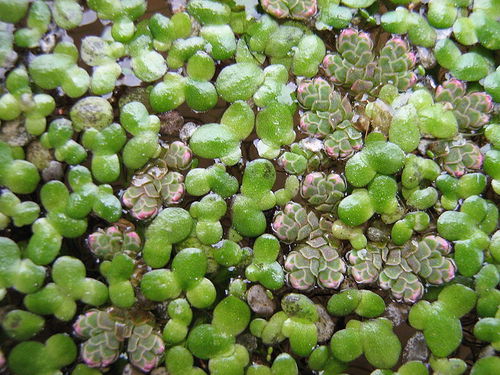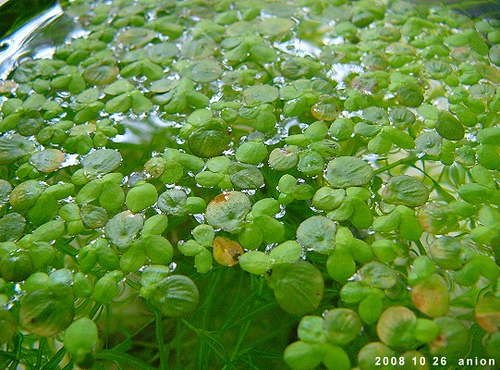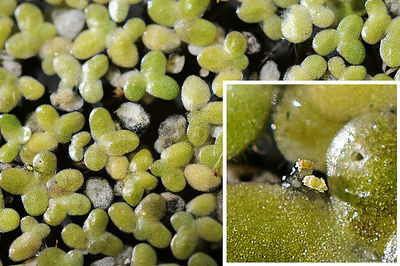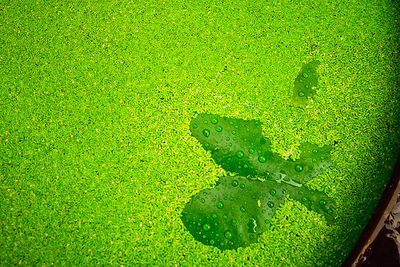Duckweed: Difference between revisions
No edit summary |
|||
| (57 intermediate revisions by 4 users not shown) | |||
| Line 1: | Line 1: | ||
= | [[Image:2974165721_aea201d454.jpg|right]] | ||
{{Category=Biofuel}} | |||
[[ | [[File:2951671000 18d073247c z.jpg|400px|thumb|right|duckweed flowering]] | ||
''' | ==Introduction== | ||
Duckweed (''lemnaceae'', water lentils) family are the smallest flowering plants and probably the fastest growing plant, capable of doubling its weight in 24 hours. Because of the very high productivity per surface area, duckweed holds great potential for future global villages. This tiny aquatic plant has tremendous potential for cleaning up pollution, combating global warming and feeding the world. | |||
==Culture== | |||
Duckweed grows well on wastewater that is rich in nutrients. For reasons that seem to be still poorly understood, biological contamination appears to be beneficial to duckweed growth. It therefore grows well on water contaminated with cattle dung, pig waste, human urine, biogas plant slurry, compost or other organic matter in slurry form. Other potentially good sources may be effluent from [[aquaponics]], used [[Hydroponics|hydroponic]] solution, leachate from [[silage]], perhaps [[Compost_Tea|compost tea]] or other kinds of organic nutrients. The plant likes still water and wind breaks, such as trees. | |||
Duckweed - | Duckweed integrates very well into [[aquaponics]] - that has been called [[Duckweed-Ponics|"duckweed-ponics"]]. | ||
*Doubling times can vary significantly - from 1-5 days depending on species - [http://www.mobot.org/jwcross/duckweed/duckweed-rapid_growth.htm]. This should be considered carefully when sourcing the initial duckweed and wolffia. | |||
*Duckweed has "95% moisture content" - [https://repositories.tdl.org/ttu-ir/bitstream/handle/2346/17141/31295015156515.pdf?sequence=1] | |||
[[File:Azolla filiculoides and L.minor.jpg|500px|thumb|right|An example of co-culture of [[Azolla]] and duckweed: "Azolla filiculoides and L.minor" by Mygaia at English Wikipedia (T.M.McKenzie)]] | |||
'' | ==Integrated Farming== | ||
According to research from the Tropical Ecological Farm, College of Agriculture and Forestry in Ho Chi Minh City: | |||
''"It is unique amongst plants in that its protein content can be manipulated according the nitrogen content of the water in which it is growing. This is important because it integrates with the biodigester. It is the ideal water plant to introduce into an integrated farming system because it can use the nitrogen in the effluent coming from the biodigester to enrich its protein content to a level only slightly lower than Soya Bean, approaching 35%. In terms of protein production, grown under ideal conditions in can produce 10 tonnes of protein per hectare per year. This compares with Soya bean which produces less than 1 tonne per year."'' | |||
==Duckweed as food== | |||
Depending on strain and growing conditions, duckweeds can have very high protein content of up to 50% of dry mass. High levels of vitamins are also present. The taste is remotely similar to spinach. Duckweeds have historically played a role in some east Asian cuisines (''Wolffia'' genus). Because of rapid growth and ease of cultivation, duckweeds for consumption by animals and humans are now getting more attention. | |||
''' | '''Animal food:''' food for ducks of course. Also chickens, fish ([[tilapia]]), goats, horses, cattle, pigs. It can provide all the protein needs for some breeds. | ||
'''Human food:''' Duckweed can be eaten in salads or soups, on a sandwich or as a component of vegetable spread (or as a substitute for: lettuce, spinach, water cress, alfalfa, ... ?). If grown for human consumption, make sure that there is no bacterial contamination. The dense covering of duckweed at the water surface can block out sunlight, which may allow anaerobic bacteria to grow. After harvest, duckweed can be lacto-fermented (see: [[Fermentation]] or [https://en.wikipedia.org/wiki/Lactic_acid_fermentation Wikipedia: "Lactic acid fermentation"]), which would eliminate most potential pathogens (also see: [[silage]]). | |||
'''''Lentein:''''' A commercial product of duckweed powder called [http://www.lentein.com/ "Lentein"] has been introduced by [http://www.parabel.com/services/food/lentein/ Parabel]. From the website: ''"LENTEIN protein powder has been successfully blended in dry-mix goods like chips, crackers, snack mixes, bars, and cereal clusters. It also blends well into protein powders used for sports drinks or meal replacement shakes."'' | |||
==For bio-energy== | |||
As with so many bioenergy ideas, some skepticism is in order. While duckweed has potential for biofuel production (ethanol, butanol, biogas), there may be better uses as fodder and human food. The topic was reviewed in [https://www.ncbi.nlm.nih.gov/pubmed/24985498 "Growing duckweed for biofuel production: a review"]. | |||
Duckweed | '''Duckweed ethanol:''' Duckweed can produce appreciable quantities of starch that can be readily fermented into ethanol. The total starch content of duckweed can vary from 3-75% of the dry weight depending on strain and species. Other factors like nutrients and concentration play a large role in the accumulation of starch in duckweed. Some species like [https://en.wikipedia.org/wiki/Spirodela_polyrhiza Spirodela polyrrhiza] combined with swine wastewater can contain a starch content of up to 46%. Duckweed has great potential for the development of environmentally friendly, economically viable ethanol production. | ||
'''Biogas:''': closed-loop system: use effluent from digester to grow duckweed, then use duckweed in [[biogas]] digester. | |||
''' | '''Gasification:''': dried feedstock can be burned or gasified. Ash can be recycled as fertilizer on the duckweed pond. | ||
'''[https://en.wikipedia.org/wiki/Hydrothermal_liquefaction Hydrothermal liquefaction]''' for conversion to a crude-oil like liquid. | |||
[[File:4469419678_fa36e0c45a_z.jpg|400px|thumb|right|duckweed microfarm for fish food]] | |||
==Other applications== | |||
'''Bio-sensors:''' Duckweeds are used for the detection of heavy metals and organic contaminants. | |||
'''Bioremediation:''' [[Living Machines]] for cleaning wastewater, such as blackwater (domestic sewage). | |||
[ | '''[[Biomining]]:''' of phosphorus and other minerals/nutrients from wastewater. | ||
'''Pharmaceuticals:''' Genetic modifications can give duckweeds new characteristics, such as pharmaceutical proteins and other biopharmaceuticals. | |||
'''In Space:''' food production in bioregenerative life support systems in space. [http://www.ncbi.nlm.nih.gov/pubmed/11695430] | |||
==Duckweed [[Silage]]== | |||
( | Ensiling duckweed may result in very high quality fodder, but appears to require add-ons such as molasses or sugar beet pulp (see [http://www.allaboutfeed.net/Nutrition/Diet-Formulation/2011/12/Ensiling-duckweed-gives-better-quality-AAF012530W/ source]). Pressing duckweed does not reduce the water content significantly, therefore some drying may be required in order to reduce the weight and improve transportability (consider [[Food Drying with Superheated Steam]]). | ||
---- | |||
A possible recipe (not tested yet!) for a high-quality duckweed [[silage]] product could include: | |||
1. duckweed (dried or at least partially dehydrated with reduced moisture content) | |||
2. sauerkraut juice (to add those [[Fermentation|lactofermenting]] bacteria) | |||
3. some sort of sugar to fed the bacteria (e.g. molasses) | |||
4. a small % amount of [[biochar]] as a microbial stabilizer | |||
---- | |||
==Business Model== | |||
Tamra Fakhoorian who runs the excellent blog [https://duckweedgardening.com/ "Duckweed Gardening"] has pioneered the commercialization of duckweed (see her company: [http://www.greensunproducts.com/ GreenSun Products, LLC]). Also check out the video below. | |||
<html> | |||
<iframe width="560" height="315" src="https://www.youtube.com/embed/dwwTekE7RMc" frameborder="0" allowfullscreen></iframe> | |||
</html> | |||
==Sources== | |||
*Garden Pool organization - [http://gardenpool.org/online-classes/growing-duckweed] | |||
Older patent with many details on duckweed for human consumption [http://www.google.com/patents?id=Zo8mAAAAEBAJ&dq=5269819] | ==Links: General== | ||
* Wikipedia entry on [http://en.wikipedia.org/wiki/Duckweed duckweed in general] and on [http://en.wikipedia.org/wiki/Wolffia Wolffia] | |||
* International Duckweed Association - [http://www.mobot.org/jwcross/duckweed/duckweed.htm] and Linked In page - [https://www.linkedin.com/grp/post/4463122-118967608] | |||
* Very comprehensive manual on duckweed aquaculture [http://www.p2pays.org/ref/09/08875.htm] - internal .pdf backup copy here: [http://opensourceecology.org/w/images/e/ea/Duckweed_Aquaculture.pdf] | |||
* Thesis on pig waste conversion to duckweed. Includes growth rates, such as .1-.5 grams of growth per gram of duckweed - [https://repositories.tdl.org/ttu-ir/bitstream/handle/2346/17141/31295015156515.pdf?sequence=1]. 100 g/m2 harvest per day is suggested for optimal growth (10% of mass). | |||
* Cross, J.W. (2006). The Charms of Duckweed. [http://www.mobot.org/jwcross/duckweed/duckweed.htm] | |||
* Older patent with many details on duckweed for human consumption [http://www.google.com/patents?id=Zo8mAAAAEBAJ&dq=5269819] | |||
Integrated Tilapia & Duckweed [[Aquaponics]] System [http://www.fishfarming.com/ | ==Links: Integrated Agriculture== | ||
* Duckweed as chicken feed - [https://pdf.sciencedirectassets.com/776861/1-s2.0-S0032579119X60812/1-s2.0-S0032579119329542/main.pdf?X-Amz-Security-Token=IQoJb3JpZ2luX2VjEPT%2F%2F%2F%2F%2F%2F%2F%2F%2F%2FwEaCXVzLWVhc3QtMSJIMEYCIQCQIV%2B80XyiE7gnVGPalbnn79IRlbs7aZ1wmg6PM6RWhQIhAI2R65lFdrPFPgz7w%2F%2BIIamg7muOqWZvrZbNmC5%2FsQXgKrQDCEwQAxoMMDU5MDAzNTQ2ODY1IgxaaYQY3ACr2iDiiS8qkQP%2BLaeJ1B%2BBCOOmxjxd0tjXeJZvoryXNP%2FvDrBs%2FzS6Hu6h1%2Fv%2FcFDIgfEQnz7i3QSRKX%2BMOOGrHg6JVgj28IJT6bgcZgisOpj2%2B%2FPYJVlemToG%2FYjcVMio5sfnsLxRe%2FU92B%2F%2FYojt%2BPGHc%2FftqTEw2tTo2Fng4Vgdfw%2B9iYERT06Jr3nNY6WYtnpGIt%2Fsvoz9po2o%2FUDxVqrpuK6fhNlwVjCA8IY0sYaVvBRa37lxxtxhr9pArWFs1L4AjU9kZoehMYoVHjQjTeuQhQ1Hd77AP2VMgORah2PtXk10a3Td%2FYsDT7LppQMonQ8606F3c3MsdhkQQGnUpz4hdHmgkncb2RDVVF5tpiHtK5qhmszvjo%2FDnTmFlM01t2%2BTN2hDp5Jha9bkoeWroaBF6Os2Z%2F6kSMKfoj%2FboErTwiJQnaxUy8IVHz91hWxSXnCUjRh9sVFvc1pw4EBZWChpNVSeObeIq%2BLvExxew1x2RnwQcxtoSKyz1xgf1p4NJi7ZbqLygdDAOdGgsjiP2OazAjAqYuuPzjCbq%2Bz8BTrqAfmVvjPxPfwKyHyF1oCTO9D7icb4trQfQ0onIp9KM0YPQNqe9%2FxLfz%2Bu4ikWiCjz2VIMOhgycphl2RWiwDBYOPaSBenJtDj7Ks7X0D%2BnXWmiyH0VBXv9AX8HUrivrOA%2FRisONpXnYTIB7ErYzZlYAaviwNB1KNrTF2E1CmKjKZJHSpR14ZPQ%2Bb%2FtHq24ONVyNFRdUq8zEfg5efaPKmBuIimZoYutDBQz1RqjcbEzOglZypIPG52KD%2B7mUNOskbytFKADasproyvBHbH1FqI3%2FLI1GkoQL3bfLvhJ00ntaLp%2BIU4DB6H6xBbknA%3D%3D&X-Amz-Algorithm=AWS4-HMAC-SHA256&X-Amz-Date=20201029T194740Z&X-Amz-SignedHeaders=host&X-Amz-Expires=300&X-Amz-Credential=ASIAQ3PHCVTY25UOEQ42%2F20201029%2Fus-east-1%2Fs3%2Faws4_request&X-Amz-Signature=1e4c8ded96af6971468b929524a8fc534bb8b7d8ef3821d6f1e662139a2f7c71&hash=5297882a5fdec4cc1838b6147a1c3a415bcc340f40775b0de8a5f1c08c8df017&host=68042c943591013ac2b2430a89b270f6af2c76d8dfd086a07176afe7c76c2c61&pii=S0032579119329542&tid=spdf-90c429b3-a3b0-48f7-8572-eba85623cf1d&sid=3249b67f483e934b4c19e191ca6b71233ce0gxrqa&type=client] | |||
* Duckweed as a feed supplement for livestock [http://www.mobot.org/jwcross/duckweed/feed-supplement.htm] | |||
* Duckweed as a Primary Feedstock for Aquaculture - duckweed has a higher conversion ratio in tilapia than commercial feed, though intake rate is lower so slower growth occurs overall. 10-20 dry tons/hectare growth are common. [http://www.mobot.org/jwcross/duckweed/Fish.htm]. '''That is 1 kg dry yield per square meter per year - or 20 kg wet mass per year - or about 50 grams wet weight per square meter per day. For a greenhouse 50 feet long with 10 troughs vertically of 6" width , that is up to 1.25 kg of duckweed production per day - or about 60 grams of dry duckweed mass per day. | |||
* Integrated Tilapia & Duckweed [[Aquaponics]] System [http://www.fishfarming.com/duckweed.html]. Download: [[File:Aquasol,Inc.pdf]] | |||
* Manual for the use of biodigester effluent and ponds for duckweed production (from Vietnam) [http://www.fao.org/WAICENT/FAOINFO/AGRICULT/AGA/AGAP/FRG/Recycle/dweed/mandw.htm] | |||
==Links: Biofuel== | |||
* Practical applications of duckweed, such as biofuel - [http://www.mobot.org/jwcross/duckweed/duckweed.htm] | |||
* Biofuels Wiki: [http://www.biofuelswiki.org/Home/Duckweed Duckweed] | |||
* book by Christopher Kinkaid (2014): [http://www.amazon.com/Duckweed-Ethanol-Biomass-International-Production/dp/1500485764 Duckweed Ethanol: Duckweed Biomass Grown from Organic Wastes to Replace Corn for US and International Ethanol Biofuel Production] | |||
[[Category:Food and Agriculture]] | [[Category:Food and Agriculture]] | ||
Latest revision as of 19:56, 29 October 2020
Introduction
Duckweed (lemnaceae, water lentils) family are the smallest flowering plants and probably the fastest growing plant, capable of doubling its weight in 24 hours. Because of the very high productivity per surface area, duckweed holds great potential for future global villages. This tiny aquatic plant has tremendous potential for cleaning up pollution, combating global warming and feeding the world.
Culture
Duckweed grows well on wastewater that is rich in nutrients. For reasons that seem to be still poorly understood, biological contamination appears to be beneficial to duckweed growth. It therefore grows well on water contaminated with cattle dung, pig waste, human urine, biogas plant slurry, compost or other organic matter in slurry form. Other potentially good sources may be effluent from aquaponics, used hydroponic solution, leachate from silage, perhaps compost tea or other kinds of organic nutrients. The plant likes still water and wind breaks, such as trees.
Duckweed integrates very well into aquaponics - that has been called "duckweed-ponics".
- Doubling times can vary significantly - from 1-5 days depending on species - [1]. This should be considered carefully when sourcing the initial duckweed and wolffia.
- Duckweed has "95% moisture content" - [2]

Integrated Farming
According to research from the Tropical Ecological Farm, College of Agriculture and Forestry in Ho Chi Minh City:
"It is unique amongst plants in that its protein content can be manipulated according the nitrogen content of the water in which it is growing. This is important because it integrates with the biodigester. It is the ideal water plant to introduce into an integrated farming system because it can use the nitrogen in the effluent coming from the biodigester to enrich its protein content to a level only slightly lower than Soya Bean, approaching 35%. In terms of protein production, grown under ideal conditions in can produce 10 tonnes of protein per hectare per year. This compares with Soya bean which produces less than 1 tonne per year."
Duckweed as food
Depending on strain and growing conditions, duckweeds can have very high protein content of up to 50% of dry mass. High levels of vitamins are also present. The taste is remotely similar to spinach. Duckweeds have historically played a role in some east Asian cuisines (Wolffia genus). Because of rapid growth and ease of cultivation, duckweeds for consumption by animals and humans are now getting more attention.
Animal food: food for ducks of course. Also chickens, fish (tilapia), goats, horses, cattle, pigs. It can provide all the protein needs for some breeds.
Human food: Duckweed can be eaten in salads or soups, on a sandwich or as a component of vegetable spread (or as a substitute for: lettuce, spinach, water cress, alfalfa, ... ?). If grown for human consumption, make sure that there is no bacterial contamination. The dense covering of duckweed at the water surface can block out sunlight, which may allow anaerobic bacteria to grow. After harvest, duckweed can be lacto-fermented (see: Fermentation or Wikipedia: "Lactic acid fermentation"), which would eliminate most potential pathogens (also see: silage).
Lentein: A commercial product of duckweed powder called "Lentein" has been introduced by Parabel. From the website: "LENTEIN protein powder has been successfully blended in dry-mix goods like chips, crackers, snack mixes, bars, and cereal clusters. It also blends well into protein powders used for sports drinks or meal replacement shakes."
For bio-energy
As with so many bioenergy ideas, some skepticism is in order. While duckweed has potential for biofuel production (ethanol, butanol, biogas), there may be better uses as fodder and human food. The topic was reviewed in "Growing duckweed for biofuel production: a review".
Duckweed ethanol: Duckweed can produce appreciable quantities of starch that can be readily fermented into ethanol. The total starch content of duckweed can vary from 3-75% of the dry weight depending on strain and species. Other factors like nutrients and concentration play a large role in the accumulation of starch in duckweed. Some species like Spirodela polyrrhiza combined with swine wastewater can contain a starch content of up to 46%. Duckweed has great potential for the development of environmentally friendly, economically viable ethanol production.
Biogas:: closed-loop system: use effluent from digester to grow duckweed, then use duckweed in biogas digester.
Gasification:: dried feedstock can be burned or gasified. Ash can be recycled as fertilizer on the duckweed pond.
Hydrothermal liquefaction for conversion to a crude-oil like liquid.
Other applications
Bio-sensors: Duckweeds are used for the detection of heavy metals and organic contaminants.
Bioremediation: Living Machines for cleaning wastewater, such as blackwater (domestic sewage).
Biomining: of phosphorus and other minerals/nutrients from wastewater.
Pharmaceuticals: Genetic modifications can give duckweeds new characteristics, such as pharmaceutical proteins and other biopharmaceuticals.
In Space: food production in bioregenerative life support systems in space. [3]
Duckweed Silage
Ensiling duckweed may result in very high quality fodder, but appears to require add-ons such as molasses or sugar beet pulp (see source). Pressing duckweed does not reduce the water content significantly, therefore some drying may be required in order to reduce the weight and improve transportability (consider Food Drying with Superheated Steam).
A possible recipe (not tested yet!) for a high-quality duckweed silage product could include:
1. duckweed (dried or at least partially dehydrated with reduced moisture content)
2. sauerkraut juice (to add those lactofermenting bacteria)
3. some sort of sugar to fed the bacteria (e.g. molasses)
4. a small % amount of biochar as a microbial stabilizer
Business Model
Tamra Fakhoorian who runs the excellent blog "Duckweed Gardening" has pioneered the commercialization of duckweed (see her company: GreenSun Products, LLC). Also check out the video below.
Sources
- Garden Pool organization - [4]
Links: General
- Wikipedia entry on duckweed in general and on Wolffia
- International Duckweed Association - [5] and Linked In page - [6]
- Very comprehensive manual on duckweed aquaculture [7] - internal .pdf backup copy here: [8]
- Thesis on pig waste conversion to duckweed. Includes growth rates, such as .1-.5 grams of growth per gram of duckweed - [9]. 100 g/m2 harvest per day is suggested for optimal growth (10% of mass).
- Cross, J.W. (2006). The Charms of Duckweed. [10]
- Older patent with many details on duckweed for human consumption [11]
Links: Integrated Agriculture
- Duckweed as chicken feed - [12]
- Duckweed as a feed supplement for livestock [13]
- Duckweed as a Primary Feedstock for Aquaculture - duckweed has a higher conversion ratio in tilapia than commercial feed, though intake rate is lower so slower growth occurs overall. 10-20 dry tons/hectare growth are common. [14]. That is 1 kg dry yield per square meter per year - or 20 kg wet mass per year - or about 50 grams wet weight per square meter per day. For a greenhouse 50 feet long with 10 troughs vertically of 6" width , that is up to 1.25 kg of duckweed production per day - or about 60 grams of dry duckweed mass per day.
- Integrated Tilapia & Duckweed Aquaponics System [15]. Download: File:Aquasol,Inc.pdf
- Manual for the use of biodigester effluent and ponds for duckweed production (from Vietnam) [16]
Links: Biofuel
- Practical applications of duckweed, such as biofuel - [17]
- Biofuels Wiki: Duckweed
- book by Christopher Kinkaid (2014): Duckweed Ethanol: Duckweed Biomass Grown from Organic Wastes to Replace Corn for US and International Ethanol Biofuel Production


